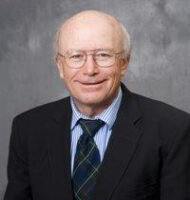 Purdue University - Extension - Forestry and Natural Resources
Purdue University - Extension - Forestry and Natural Resources
Got Nature? Blog
Before embarking on a 40-plus year career guiding students and constituents across the state on the topics of timber tax and forest economics, becoming known as the Purdue Forestry and Natural Resources historian or pitching in on various community projects to promote forest maintenance and recreation, Dr. Bill Hoover began his career of service in the U.S. Army Corps of Engineers as a basic training officer and later a combat engineering battalion operations officer in Vietnam.
Hoover grew up with military men on both sides of his family and was mentored by several World War II veterans as a member of the Boy Scouts.
“Most of my Boy Scout leaders took it as their role to prepare us for military service,” Hoover explained. “Attending Penn State, a land grant college, meant I was required to take ROTC courses and drills for two years. Advanced ROTC seemed like the logical choice since serving as an officer was better than as an enlisted grunt.”
After graduating from Penn State in December 1966 with his bachelor’s degree in forest management and a commission as a second lieutenant reserve officer in the U.S. Army, Hoover reported for training in Ft. Belvoir, Virginia, where he learned to be a combat engineer junior officer. From there, he moved on to Ft. Lewis, Washington, where he taught classes on all phases of military life and supervised enlisted officers, and finally to the Mojave Desert, where he participated in training evaluation. Just after Christmas in 1967, Hoover deployed to Vietnam as a combat engineer in the 39th engineer battalion, 18th engineer brigade.
Just over a year later, Hoover returned home on Dec. 29, 1968, and was relieved from active duty two weeks later. Months later, he was awarded a Bronze Star for Meritorious Service for his efforts, which included everything from construction of bunkers and other structures to bridge building and culvert replacements, supervision of material distribution to field companies, and daily mine sweeps.
“I don’t remember ever firing my weapon. I learned to work with men in tough situations and I experienced a new culture,” Hoover said. “The recommendation from the Battalion Commander got me into graduate school at Penn State, not my academic record. The GI Bill with the assistantship provide sufficient income to lead a pleasant life in State College. I didn’t use up the GI Bill benefit until my first year at Iowa State University for my PhD program.”
In 1974-75, an influx of talent joined the FNR faculty ranks. Joe O’Leary, Harmon “Mickey” Weeks, Harvey Holt, Ann Spacey and Bill Hoover were all hired that year and all would go on to join the ranks of FNR’s professor emeritus list.
“Mr. Bill Hoover, a candidate for the PhD in economics from Iowa State, joined the faculty as a teacher and research in forest economics with a specialization in econometrics,” first year department head Mason Carter said in his opening letter of the 1975 FNR Log book.
While Hoover may have been hired for his knowledge of econometrics, or the application of statistics and economic models, he would make his impact on the department in other ways.
“My value appeared to be in other places and I was hired to work with the folks in the wood research lab in marketing and feasibility studies working with Carl Eckelman on laminated veneer lumber and Mike Hunt on composite panels,” Hoover said. “The nature of the work was to identify potential markets, help design a product that would best serve those, produce samples, test them and give samples to potential use adopters. Laminated veneer and lumber type products were less common at the time. The price of lumber got high enough that substitute products made sense and I did economic feasibility studies for the manufacturers of the products.”
Hoover’s name also became synonymous with wood products throughout the state of Indiana through his production of the Indiana Forest Products Price Report, a yearly publication he undertook his second year at Purdue and continued until he handed it off to the Indiana Division of Forestry upon his retirement in 2013. The later-defunct publication is currently being revived in a virtual format by Dr. Mo Zhou.
“It was a survey of mills,” Hoover explained. “It was a questionnaire asking for the prices they paid for delivered logs for a wide variety of species, for sawed logs of four grades and of veneer logs of five species and two grades. It was done in cooperation with Ag statistics. I maintained the mailing list and they mailed it out. It had increased validity come from that group.”
To view this full article, please visit our 2023 FNR News & Stories page.
Resources:
FNR Former Faculty
Investing in Indiana Woodlands, The Education Store, Purdue Extension’s resource center
Financial and Tax Aspects of Tree Planting, The Education Store
Determining Tax Basis of Timber, The Education Store
How to Treat Timber Sale Income, The Education Store
Protection of Forest Land in Indiana, The Education Store
Tax Treatment of Conservation Easements, The Education Store
Marketing Timber, The Education Store
Tips on How to Get the Most from Your Timber Harvest, The Education Store
Predicting Black Walnut Log Prices, The Education Store
Wendy Mayer, FNR Communications Coordinator
Purdue University Department of Forestry and Natural Resources

Recent Posts
- A Woodland Management Moment: Black Walnut in Pine Plantation
Posted: December 19, 2025 in Forestry, Forests and Street Trees, Urban Forestry, Woodlands - ID That Tree: Sugarberry
Posted: December 12, 2025 in Forestry, Wildlife, Woodlands - Powering Rural Futures: Purdue’s Agrivoltaics Initiative for Sustainable Growth
Posted: December 9, 2025 in Community Development, Wildlife - Learn How to Control Reed Canarygrass
Posted: December 8, 2025 in Forestry, Invasive Plant Species, Wildlife - Benefits of a Real Christmas Tree, Hoosier Ag Today Podcast
Posted: December 5, 2025 in Christmas Trees, Forestry, Woodlands - Succession Planning Resource: Secure your Future
Posted: December 2, 2025 in Community Development, Land Use, Woodlands - A Woodland Management Moment: Butternut Disease and Breeding
Posted: December 1, 2025 in Forestry, Forests and Street Trees, Woodland Management Moment, Woodlands - Controlling Introduced Cool-Season Grasses
Posted: in Forestry, Invasive Plant Species, Wildlife - Red in Winter – What Are Those Red Fruits I See?
Posted: in Forestry, Plants, Urban Forestry, Wildlife, Woodlands - Managing Common and Cut Leaved Teasel
Posted: November 24, 2025 in Forestry, Invasive Plant Species, Wildlife
Archives
Categories
- Alert
- Aquaculture/Fish
- Aquatic/Aquaculture Resources
- Ask the Expert
- Christmas Trees
- Community Development
- Disease
- Drought
- Forestry
- Forests and Street Trees
- Gardening
- Got Nature for Kids
- Great Lakes
- How To
- Invasive Animal Species
- Invasive Insects
- Invasive Plant Species
- Land Use
- Natural Resource Planning
- Nature of Teaching
- Plants
- Podcasts
- Ponds
- Publication
- Safety
- Spiders
- Timber Marketing
- Uncategorized
- Urban Forestry
- Webinar
- Wildlife
- Wood Products/Manufacturing
- Woodland Management Moment
- Woodlands